

Skylake (microarchitecture) An initial batch of Skylake CPUs (6600K and 6700K) was announced for immediate availability during the Gamescom on August 5, 2015,[1] unusually soon after Broadwell.

RCC Reference Platform for the Intel Atom Processor C2000 Family (Rangeley) Overview ADI Engineering’s RCC is a production-ready Mini-ITX reference platform based on the Intel® Atom™ Processor C2000 Family (Rangeley) that helps OEMs speed innovative entry-level SDN and OpenFlow, network security, and communications products to market.
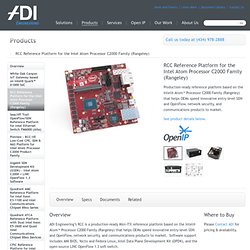
Software support includes AMI BIOS, Yocto and Fedora Linux, Intel Data Plane Development Kit (DPDK), and the open-source LINC OpenFlow 1.3 soft switch. ADI offers the RCC platform as a development kit and a custom-branded volume OEM board or turnkey system. We can also rapidly customize RCC hardware and software (including its freely available OpenFlow 1.3 implementation) to specific OEM requirements ranging from simple reconfiguration to full customization. ADI quickly scales RCC-based OEM products to volume production under our “Open IP” model with quick time to market, customer optional design ownership and complete production control. PLX Technology : PCI Gen 2 Express Switches : PEX 8624. Home > Products > PCI Express Family > PCI Express Gen 2 > PEX 8624 24-Lane, 6-Port PCI Express Gen 2 (5.0 GT/s) Switch, 19 x 19mm FCBGA The ExpressLane™ PEX 8624 device offers 24 PCI Express Gen 2 (5.0 GT/s) lanes, capable of configuring up to 6 flexible ports.

The switch conforms to the PCI Express Base Specification, rev 2.0. The 24-lane switch enables users to add scalable, high bandwidth, non-blocking interconnection to a wide variety of applications including workstations, communications, storage, and embedded systems as well as intelligent I/O modules and add-in cards. 모니터&모바일 - 결론. SONY VAIO Pro 13 Ultrabook은...
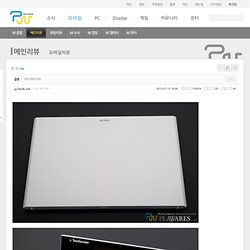
인텔에서 정한 울트라북의 기준을 준수하게 지킨 제품으로, 1.06 kg의 가벼운 무게(터치패널제품 중 가장 가벼운 무게)와 16.9 mm의 얇은 두께, 이전 세대의 디자인을 계승하면서도 컨실드 힌지를 적용하여 더욱 깔끔한 디자인을 자랑하고 있습니다. SSD IO Speed vs. Read/Write Ratio - Fusion-io ioDrive 320 GB MLC. Www.southampton.ac.uk/~sjc/raspberrypi/pi_supercomputer_southampton.htm. Return to View video at:

Downloads. Never Miss A Word. 네이버 블로그. Arduino. Arduino is an open-source computer hardware and software company, project and user community that designs and manufactures kits for building digital devices and interactive objects that can sense and control the physical world.[1] Arduino boards may be purchased preassembled, or as do-it-yourself kits; at the same time, the hardware design information is available for those who would like to assemble an Arduino from scratch.
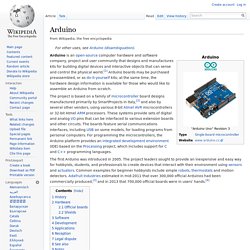
The first Arduino was introduced in 2005. The project leaders sought to provide an inexpensive and easy way for hobbyists, students, and professionals to create devices that interact with their environment using sensors and actuators. Common examples for beginner hobbyists include simple robots, thermostats and motion detectors. Arduino - HomePage. Smart Phone. LG Optimus Black. The LG P970 Optimus Black is a smartphone designed and manufactured by LG Electronics and was released in 2011.

At 9.2 mm in thickness, it was LG's thinnest smartphone at the time of its release, and is slightly thinner than the iPhone 4. The LG Optimus Black features a WVGA NOVA display which is brighter than competitor displays with brightness officially claimed to be over 700 nits. However, the actual brightness of the screen is measured to be about 749 nits.[4] Furthermore, the NOVA display consumes less energy compared to competitor displays.[5] LG Optimus Black is claimed to be the first smartphone with 2MP front camera.
WLAN. Wi-Fi. Wi-Fi, also spelled Wifi or WiFi, is a technology that allows an electronic device to exchange data or connect to the internet wirelessly using 2.4 GHz UHF and 5 GHz SHF radio waves.
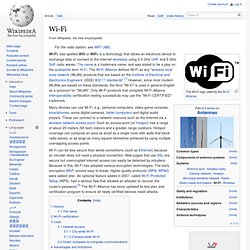
The name is a trademark name, and was stated to be a play on the audiophile term Hi-Fi. IEEE 802.11n-2009. IEEE 802.11n-2009, commonly shortened to 802.11n, is a wireless networking standard that uses multiple antennas to increase data rates.
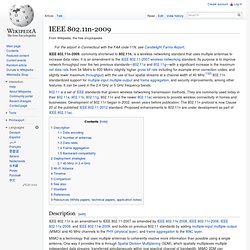
It is an amendment to the IEEE 802.11-2007 wireless networking standard. Its purpose is to improve network throughput over the two previous standards—802.11a and 802.11g—with a significant increase in the maximum net data rate from 54 Mbit/s to 600 Mbit/s (slightly higher gross bit rate including for example error-correction codes, and slightly lower maximum throughput) with the use of four spatial streams at a channel width of 40 MHz.[1][2] 802.11n standardized support for multiple-input multiple-output and frame aggregation, and security improvements, among other features. It can be used in the 2.4 GHz or 5 GHz frequency bands. 802.11 is a set of IEEE standards that govern wireless networking transmission methods. Description[edit] InfiniBand. InfiniBand is a switched fabric computer network communications link used in high-performance computing and enterprise data centers.
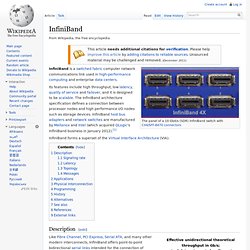
InfiniBand forms a superset of the Virtual Interface Architecture (VIA). Description[edit] Like Fibre Channel, PCI Express, Serial ATA, and many other modern interconnects, InfiniBand offers point-to-point bidirectional serial links intended for the connection of processors with high-speed peripherals such as disks. On top of the point to point capabilities, InfiniBand also offers multicast operations. It supports several signaling rates and, as with PCI Express, links can be bonded together for additional throughput. Ethernet Controller X540-AT2. 82599ES 10 Gigabit Ethernet Controller. Ethernet Converged Network Adapter X520-DA2. 제공된 모든 정보는 언제든 예고 없이 변경될 수 있습니다. Motherboards. CTS-1000 Cleantech Server ® ASRock Rack > C2750D4I. PCI Express. PCI Express (Peripheral Component Interconnect Express), officially abbreviated as PCIe, is a high-speed serial computer expansion bus standard designed to replace the older PCI, PCI-X, and AGP bus standards.
PCIe has numerous improvements over the aforementioned bus standards, including higher maximum system bus throughput, lower I/O pin count and smaller physical footprint, better performance-scaling for bus devices, a more detailed error detection and reporting mechanism (Advanced Error Reporting (AER)[1]), and native hot-plug functionality. More recent revisions of the PCIe standard support hardware I/O virtualization. The PCIe electrical interface is also used in a variety of other standards, most notably ExpressCard, a laptop expansion card interface. 기글 하드웨어 정보 게시판 - PCI-E 3.0 기술과 발전. NVM Express. NVM Express, NVMe, or Non-Volatile Memory Host Controller Interface Specification (NVMHCI), is a specification for accessing solid-state drives (SSDs) attached through the PCI Express (PCIe) bus.
NVM is an acronym for non-volatile memory, as used in SSDs. A major application of NVMe is SATA Express, which is a new and backward-compatible interface specification supporting either SATA or PCI Express storage devices. SATA Express can use either legacy AHCI or new NVMe as the logical device interface.[1] Background[edit] Near field communication. A summary of near-field communication Near field communication (NFC) is a set of ideas and technology that enables smartphones and other devices to establish radio communication with each other by touching the devices together or bringing them into proximity to a distance of typically 10 cm (3.9 in) or less. Early business models such as advertising and industrial applications were not successful, having been overtaken by alternative technologies such as barcodes or UHF tags, but what distinguishes NFC is that devices are often cloud connected.
Serial Peripheral Interface Bus. SPI bus: single master and single slave Interface[edit] The MOSI/MISO convention requires that SDI on the master be connected to SDO on the slave, and vice versa. Chip select polarity is rarely active high, although some notations (such as SS or CS instead of nSS or nCS) suggest otherwise. SPI port pin names for particular IC products may differ from those depicted in these illustrations. The master does not use an addressing concept while communicating with the slave. 직렬포트, 병렬포트. PCIe-7841R - R Series Multifunction RIO with Virtex-5 LX30 FPGA. La carte RIO (E/S reconfigurables) multifonction NI PCIe-7841R intègre un FPGA programmable par l'utilisateur pour le traitement embarqué et pour un fonctionnement flexible des E/S. Toutes les fonctionnalités analogiques et numériques sont configurées en utilisant les diagrammes graphiques NI LabVIEW et le Module LabVIEW FPGA. Le diagramme s'exécute dans le matériel, en vous donnant un contrôle direct et immédiat de tous les signaux d'E/S, pour offrir des capacités hautes performances : - un contrôle complet de la synchronisation et du cadencement de toutes les opérations et de tous les signaux - une prise de décision embarquée personnalisée qui s'exécute avec une vitesse et une fiabilité cadencées de façon matérielle - des lignes numériques configurables individuellement comme entrées, sorties, compteurs/timers, modulation de la largeur d'impulsion (PWM), entrées d'encodeur flexibles ou protocoles de communication spécialisés.
VMEbus. VME64 crate with, from left, an ADC module, a scaler module and a processor module History[edit] In 1979, during development of the Motorola 68000 CPU, one of their engineers, Jack Kister, decided to set about creating a standardized bus system for 68000-based systems. The Motorola team brainstormed for days to select the name VERSAbus. VERSAbus cards were large, 14.5" by 9.25", and used edge connectors.[1] Only a few products adopted it, including the IBM System 9000 instrument controller and the Automatix robot and machine vision systems. VERSAbus memory card. VME eXtensions for Instrumentation. The VXI bus architecture is an open standard platform for automated test based upon VMEbus.
VXI stands for VME eXtensions for Instrumentation, defining additional bus lines for timing and triggering as well as mechanical requirements and standard protocols for configuration, message-based communication, multi-chassis extension, and other features. In 2004, the 2eVME extension was added to the VXI bus specification, giving it a maximum data rate of 160 MB/s. The VXIbus grew from the VME bus specification, it was established in 1987 by Hewlett Packard (now Agilent Technologies), Racal Instruments (now EADS North America Test and Services), Colorado Data Systems, Wavetek and Tektronix. The VXIplug&play Alliance specified additional hardware and software interoperability standards, notably the Virtual Instrument Software Architecture or VISA, although the alliance was eventually merged with the IVI Foundation.
References[edit] RapidIO. Current Specifications. IEEE-488.